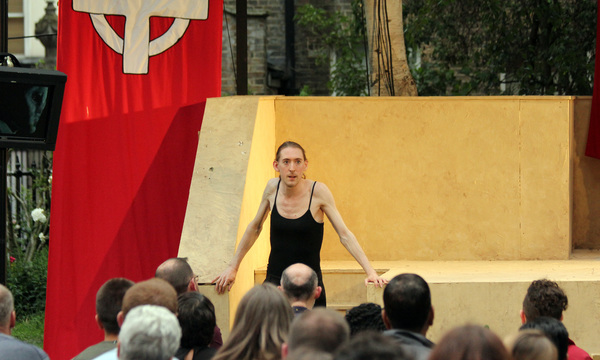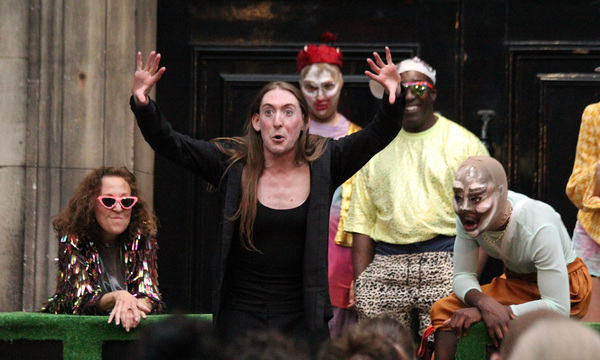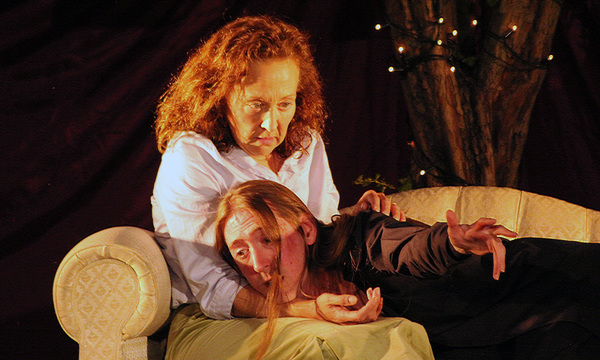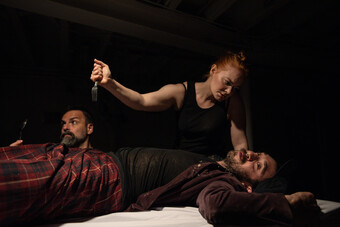Hamlet as character and Le Lacheur as actor dominate the play, but a trans Hamlet, and an electric cast, compel the audience to see the other characters in a new light through how they relate to Hamlet. Throughout the course of the play, says Le Lacheur, “there are so many moments where Hamlet gets misgendered, that it’s like a shorthand for [their] relationship” with the character who misgenders them. As their university friend, only Horatio really knows Hamlet: he correctly genders Hamlet when it’s only the two of them, they share intimate embraces and near kisses, and it’s around only Horatio who Hamlet initially feels at ease to shed their oversized jacket and expose their feminine clothing. By contrast, Rosencrantz and Guildenstern’s failure to recognize Hamlet’s gender identity further underscores that those formerly close to them cannot see them for who they have become.
Hamlet is caught performing the trappings of masculinity for those to whom they are not out—that is, their family, the court, and their old friends. Hamlet’s reluctance to be out full-time and their vacillation around carrying out the murder of Claudius both originate in their “internalized roadblocks” about their father, as Le Lacheur describes them. Those roadblocks come partially from the dramaturgical decision to portray Old Hamlet as not just a fascist tyrant but also a domestic abuser. Audiences experience the manipulative control of Hamlet’s late father when, during Hamlet’s first encounter with the ghost, Hamlet compulsively mirrors the same choreography as their father, who then grips his child’s head and speaks his lines through them. The influence of the ghost of Old Hamlet lingers like a bruise on the performance: Hamlet’s fawning behavior towards the memory of their father and their idealization of his toxic cis masculinity, Hamlet’s despairing intonation of “I must be cruel in order to be kind” to their mother after killing Polonius; even Hamlet’s anxious tic of clutching of their forearm, especially when they speak of their father.
Hamlet is caught performing the trappings of masculinity for those to whom they are not out—that is, their family, the court, and their old friends.
Moments of internalized misogyny are presented—Hamlet speaking “frailty, thy name is woman” rings as self-criticism, and them uttering, in defeat, “why, what an ass am I” as they remove the stiletto heels they had so joyously donned to dance with the tragedians. And there is a moment of desperate survivors’ solidarity, when Hamlet and their mother exchange a knowing look of despair after Claudius demands that Gertrude not drink the poisoned wine.
“They never got to come out to their father,” Le Lacheur says of this production’s Hamlet. “I think they imagine that if they had, because [they thought] their father was this unimpeachably perfect person, [their father] would have been totally cool with it. [But he] totally wouldn’t [have been].” A lifetime of carefully calculated self-preservation from gendered violence and humiliation is metonymously contained in Hamlet’s stack of love notes that Ophelia returns. They are written on scraps of paper in bold primary colors, which La Lacheur says they chose to signify Hamlet’s imitation of how they think a man should act. The notes might express real love for Ophelia, Le Lacheur says, but “the way that they’re said, and the way that they look, comes from a place of a trans girl going, ‘What do boys do? I’ll do that, and then no one will bother me about any trans thing.’”












Comments
The article is just the start of the conversation—we want to know what you think about this subject, too! HowlRound is a space for knowledge-sharing, and we welcome spirited, thoughtful, and on-topic dialogue. Find our full comments policy here